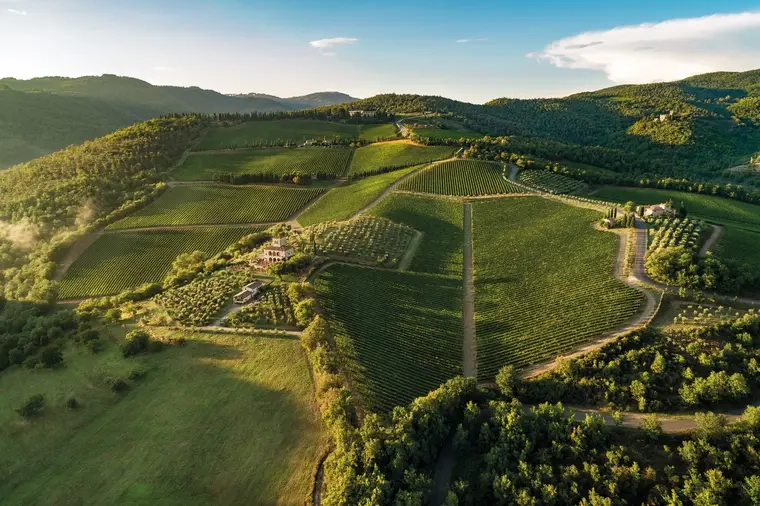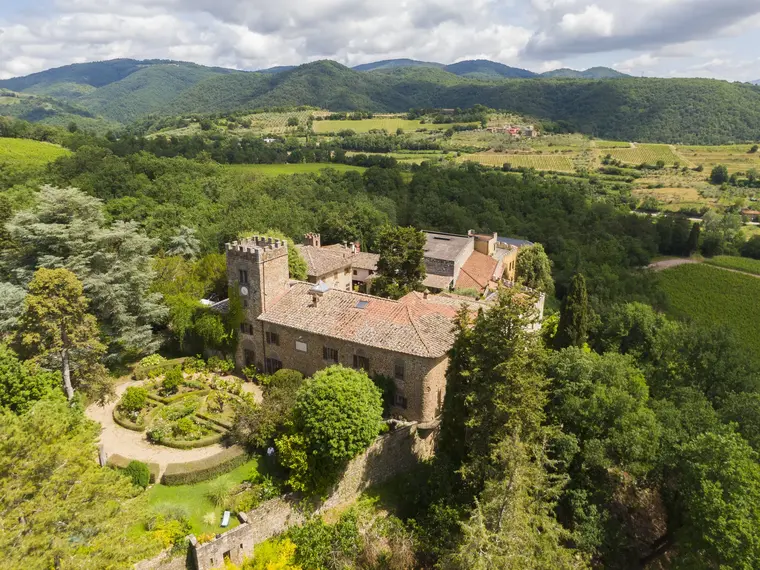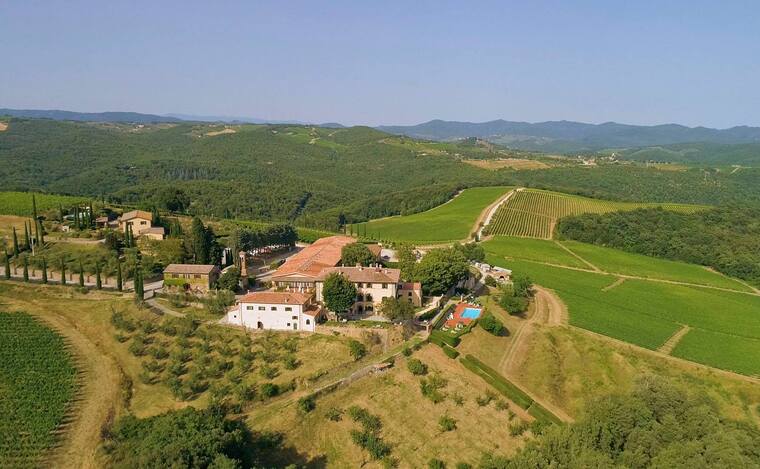13 Best Wineries to Visit in Chianti, Italy
Wine is undoubtedly one of the typical products of Tuscany, so much so that it is known, appreciated, and exported worldwide. When we think of Tuscan wine, we immediately imagine the Chianti area, one of the most renowned production areas for its great winemaking tradition and the quality of its wines. Chianti is a land of wines with an intense red color and a strong taste. Taking a tour of Chianti without visiting some of its cellars is a bit like not fully enjoying your holiday.
Historically, Chianti was a restricted area, including in the municipalities of Radda in Chianti, Gaiole in Chianti, and Castellina in Chianti. Today the territories of the municipalities of Castelnuovo Berardenga and Poggibonsi (in the province of Siena), San Casciano Val di Pesa, Tavarnelle Val di Pesa, Greve in Chianti, and part of the municipality of Barberino Val d’Elsa have also been added to the Chianti area (in the province of Florence) which represent the production area of the wine called “Chianti Classico” (recognizable by the label with the Black Rooster).
But what is the difference between Chianti and Chianti Classico? Chianti is a DOCG wine produced in the provinces of Siena, Florence, Arezzo, Pisa, Pistoia, and Prato from 75-100% Sangiovese grapes. The production of Chianti Classico DOCG, on the other hand, is restricted to only a small area between the provinces of Siena and Florence and includes the municipalities of Castellina in Chianti, Greve in Chianti, Radda in Chianti, and Gaiole in Chianti. To produce Chianti Classico, it is allowed to use Sangiovese grapes for a minimum of 80%, plus a blend of other red berried grapes suitable for cultivation in Tuscany.
If you are a wine lover, in Tuscany you will most likely have the opportunity to taste prestigious labels and to taste excellent vintage wines, perhaps combined with other local products that will delight your palate.
To choose where to go for wine tastings, you can start by deciding on the area of your interest. Otherwise, you can see which area is most convenient or closest for you to reach.
So, where to go in Chianti to have wine tastings? Here are some suggestions.
Castello di Albola
Via Pian d’Albola, 31 – Radda in Chianti –Website

Castello di Albola, owned by the Zonin family since 1979, is undoubtedly one of the historic companies of the Chianti Classico.
The Zonin family has spent the last 40 years renovating the estate and expanding the vineyards and farm, for a total of 900 hectares of land.
During the hour of visit, you will learn more about the history of the estate and especially that of Chianti Classico, with anecdotes on the composition of the wine and the various techniques of aging in barrel or barrique.
For a complete experience, the visit to the cellar can be accompanied by a tasting of 4 wines with a light lunch served in the delightful internal courtyard of the castle.
Lunch usually includes an appetizer, a first course, a second course, and a dessert.
The quality of the prepared foods is really high and makes the tasting experience unique.
The location of Albola really deserves a 360-degree eno-gastronomic visit.
Castello di Querceto
Via Alessandro François, 2 – Greve in Chianti – Website

In the municipality of Greve in Chianti, it is possible to visit the cellars of the Querceto Castle. The original building was built in the Middle Ages but was later destroyed by a fire, so much so that today only a part of the walls remains.
Since 1897 it has been owned by the François family, who, with perseverance and dedication, made it one of the historic companies of the Chianti Classico.
Today it is also a farmhouse immersed in the Tuscan countryside and surrounded by vineyards, strong in a position of total isolation and away from the busiest roads. In the cellar, the oldest bottles date back to 1904, kept as historical relics.
Badia a Coltibuono
Badia a Coltibuono,Gaiole in Chianti – Website

Badia a Coltibuono is a former abbey now converted into a luxury farmhouse. Here the tradition of wine was born with the Benedictine monks: the abbey also preserves the original structure which dates back to 1051.
And it is precisely in the archives of the abbey that the name “Chianti” appears for the first time in history, in a document from the end of the 12th century.
In the cellars the walls and the oldest bottles are covered with dark mold which helps to maintain the right level of humidity in the rooms. Badia a Coltibuono wines are all organic.
The wine tasting takes place in the largest room of the villa, decorated with 16th-century frescoes on the walls.
In addition to Chianti Classico, Chianti Riserva, Vin Santo and Supertuscan, Badia a Coltibuono also produces an excellent extra virgin olive oil.
The dark-colored Vin Santo called “Occhio di pernice” also deserves a mention.
Antinori
San Casciano Val di Pesa – Website

The Antinori family estate is located in San Casciano Val di Pesa in the province of Florence in an architecturally avant-garde space inaugurated in 2012.
Conceived to have a low environmental impact and high energy saving, the cellar was built with natural materials such as terracotta, wood, corten steel, and glass.
The Antinori marquises are among the oldest families of Italian enology, and in their new cellar, you can admire the desire for the contemporary, always remembering the past.
The cellar has been designed to allow gravity vinification and to naturally guarantee the ideal temperature for the production and storage of wine.
Among the most renowned wines produced by the Marquises Antinori are Tignanello, Solaia, and Chianti Classico Badia a Passignano Gran Selezione, which can be tasted in the “Rinuccio 1180” restaurant.
Castell’In Villa
Castelnuovo Berardenga, Siena – Website

It is a medieval village dating back to 1200 on top of a hill located in the territory of Castelnuovo Berardenga, Province of Siena, which houses one of the most elegant realities of all the Chianti Classico.
Here tradition is combined with the hospitality of an international level that is offered thanks to the bed and breakfast, the restaurant, and the farmhouse.
For fifty years, the estate led by Princess Coralia Pignatelli has been able to enhance the vineyard, bringing the Sangiovese grape to great levels.
Chianti Classico and Chianti Classico Riserva, often on the podium of important wine guides, have always known how to wait for the right time before ending up in the glass.
Inside the property, there is also the restaurant of the same name, which offers risotto with wild vegetables and tomato cubes, free-range chicken with seasonal vegetables, and sheep ricotta “Gnudi” on courgette carpaccio, with crispy pastry Parmigiano Reggiano DOP.
Erta di Radda
Case Sparse il Corno 25, Radda in Chianti – Website

Diego Finocchi has recently established himself as a young winemaker thanks to Erta di Radda, in the Radda in Chianti area: here he produces certified organic Chianti Classico obtained from Sangiovese vines dating back to 1967.
The name of this wine is intrinsically linked to the characteristics of the territory where it is born, derives in fact from the steep slopes of the vineyards (Erta = slope), located a few steps from the historic center of Radda in Chianti. The “Erta di Radda” is a small business, managed entirely by Diego, who personally takes care of all the activities, from pruning the vineyard to marketing the wine.
Fonterenza
Località Fonterenza, 99 Sant’Angelo in Colle,Montalcino – Website

The Milanese twin sisters Francesca and Margherita Padovani manage the Campi di Fonterenza farm, a reality that since 1997 has distinguished itself first for extra virgin olive oil and subsequently for Brunello di Montalcino wine. The farm was born from the passion of the two sisters for these places and for the land. Initially started in the organic regime, the company then converted to the biodynamic regime in order to keep the expression of the territory intact as much as possible inside the bottle. Three-quarters of the plot of land is surrounded by a forest of holm oaks, oaks, strawberry trees, and junipers. Currently, the company can boast about 2.5 hectares of vineyards in production all cultivated with biodynamic methods. The cellar, located on the farm and obtained from former stables and granaries, is divided into the vinification and aging space. Here the Brunello, Rosso di Montalcino and Lupo di Fonterenza wines are produced.
Le Potazzine
Località Le Prata, 262, 53024 -Montalcino – Website

This prestigious company in Montalcino is a cellar and a wine shop and it is impossible for the visitor to be disappointed by the services offered. To stock up on the award-winning Brunello you can go to the estate located in Le Prata, or you can take a walk in Piazza Garibaldi, in the heart of Montalcino, to visit the well-stocked wine shop and take off some greedy whims sitting at the table. The estate consists of five hectares of vineyards from which Brunello wine is produced, three of which are located near the cellar, at 507 meters above sea level, with an average age of 14 years. The rest are located in the Sant’Angelo in Colle area, at about 420 meters above sea level. The goal pursued since the first vinification was to produce wine in the most natural way possible. This is achieved with natural fermentations thanks to indigenous yeasts, together with long macerations and aging in medium-sized oak barrels, as per tradition, for both Brunello and Rosso di Montalcino wines.
Capannelle
Località Capannelle, 13,Gaiole in Chianti – Website

A small eighteenth-century farm overlooking the town, where wines have been produced since 1975. Among the first producers to create a half Sangiovese and half Merlot wine, Capannelle was also among the first companies to plant a Chardonnay in Chianti, obtaining great results, always maintaining great levels for its Chianti Classico Riserva and the Solare. Manuele Verdelli and Simone Monciatti are the owners who take care of these particular wines, which over the years have seen a change of ownership, the expansion of the cellar, and the construction of the famous Caveau, which houses the wines purchased by customers. The open kitchen overlooks the tasting room and, if you are lucky, you can see Giuliana and Elisa at work baking lasagna with leeks and sausage and preparing a fabulous stew with wine. Capannelle is also a small charming estate, with elegant rooms and suites, where you can spend a few relaxing days and enjoy a lunch on the terrace overlooking the Chianti area.
Dievole
Località Dievole 6, Castelnuovo Berardenga – Website

The Bulgheroni family has given Dievole a new liveliness, investing in new facilities and hospitality, bringing wines and extra virgin olive oil to very high-quality levels. Among its labels we find the Chianti Classico Gran Selezione Vigna di Sessina and the Chianti Classico Riserva Novecento, which can be tasted in the cellar or combined with the dishes of the “Novecento” restaurant. This is the realm of chef Monika Filipinska who, with enthusiasm, grace and passion, transforms the estate’s products into small masterpieces, such as tortelli with new oil or cod in oil. In the structure, you can decide whether to reserve an apartment or stay overnight in the beautiful rooms inside the historic villa, with breathtaking views of the Tuscan countryside.
Vitique-Santa Margherita Tenimenti Toscani
Greve in Chianti – Website

The Santa Margherita nel Chianti Wine Group produces wines such as Lamole di Lamole and Vistarenni. In the cellar, wines from Tuscan estates are left to age in ancient barrels – recovered thanks to careful restoration – or you can find the experimental section, dedicated to aging in modern concrete and steel vats. In the wine shop, you can also taste the other Italian wines of the Santa Margherita Wine Group, which you can then taste if you decide to stop and eat in the Vitique restaurant: egg, fluffy pumpkin, anise, and black truffle to pay homage to autumn; venison, red fruits, and chamomile; Cappelletti, ash potato, eel and porcini mushrooms are among the dishes offered by the restaurant. If you want to eat something more informal, the local bistro offers a selection of raw, pecorino cheese and honey or a grilled fillet of beef.
Castello di Ama
Località Ama in Chianti,Gaiole in Chianti – Website

The Ama estate has always been one of the cornerstones of historic Chianti: a company that has been able to integrate the ancient village and the manor houses with stone farms and the modern cellar. A place where contemporary art forged by numerous artists of the caliber of Pistoletto and Daniel Buren mixes between exterior and interior, creating evocative settings both in the cellar and outdoors. Among its most famous wines in the world, we find Merlot, L’Apparita, Chianti Classico Gran Selezione Vigneto Bellavista and Chianti Classico Gran Selezione San Lorenzo, unique and territorial wines that know how to marry perfectly with the dishes of the “Ristoro di Ama”, among whose specialties we find the guinea fowl on chestnut cream and potato tortelli with Cinta Senese pig ragù.
Brolio
Castello di Brolio ,Gaiole in Chianti – Website

If Chianti is famous all over the world today, we owe it to Bettino Ricasoli, the inventor of the Chianti formula which then evolved over the centuries. Today the Castello di Brolio is a popular destination for visitors, thanks to Francesco Ricasoli, who was able to adapt the symbol of Chianti to modern times. The Chianti Classico Gran Selezione Colledilà and the Chianti Classico Gran Selezione Roncicone, are among the most important wines of Brolio, which can be found in the wine shop, inside the Agribar, but above all, they are the perfect companions for the recipes of the Osteria del Castello, where chef Luca Aprea interprets local dishes. An example is Brolio’s Spaghetti with five tomatoes. The Chef often inserts something unusual in dishes rich in local raw materials, such as katsuobushi in black cabbage ravioli with potato, carbonara cream, blueberries, or Scallop with mango and celery and cucumber centrifuge.
Read also:







